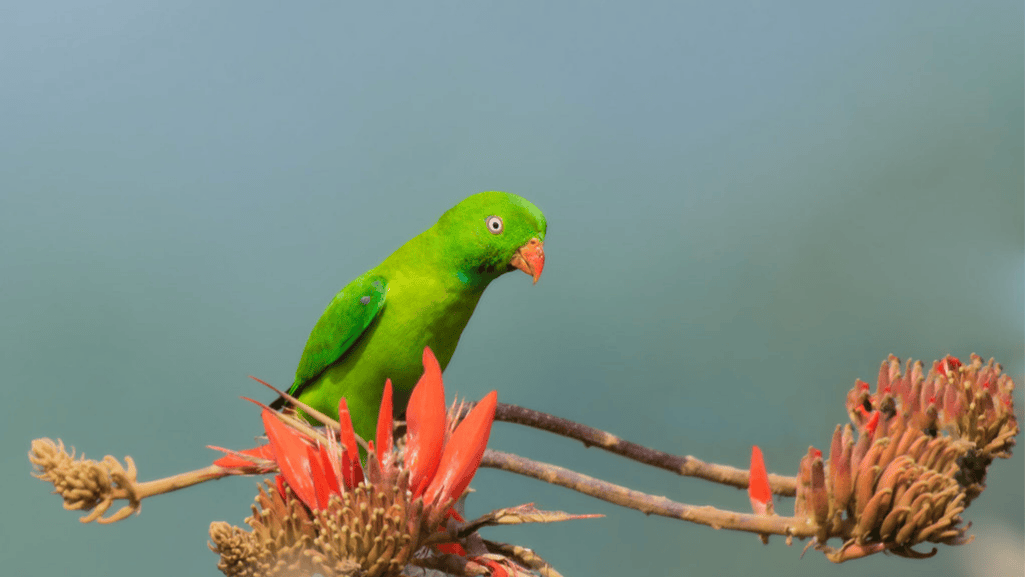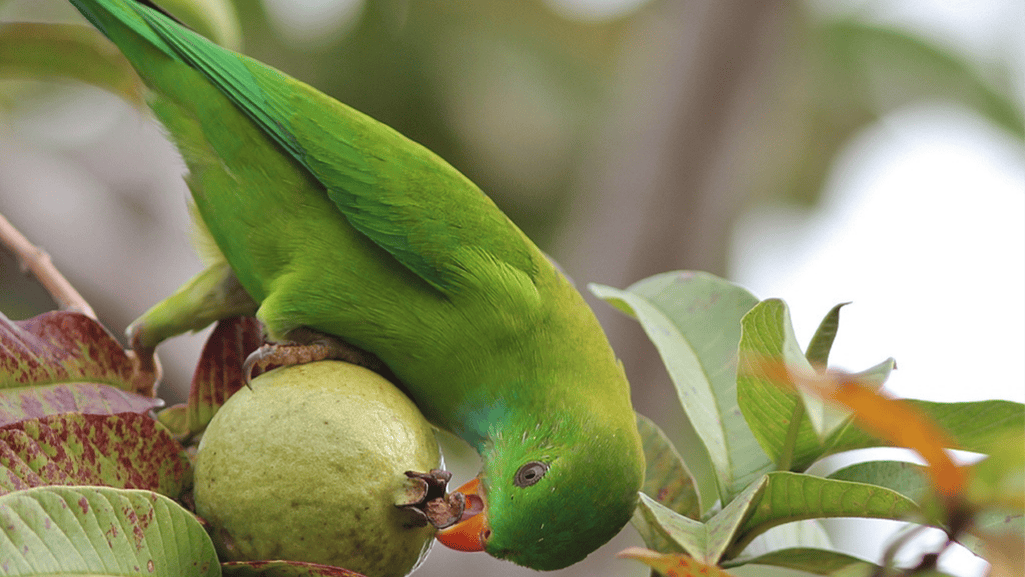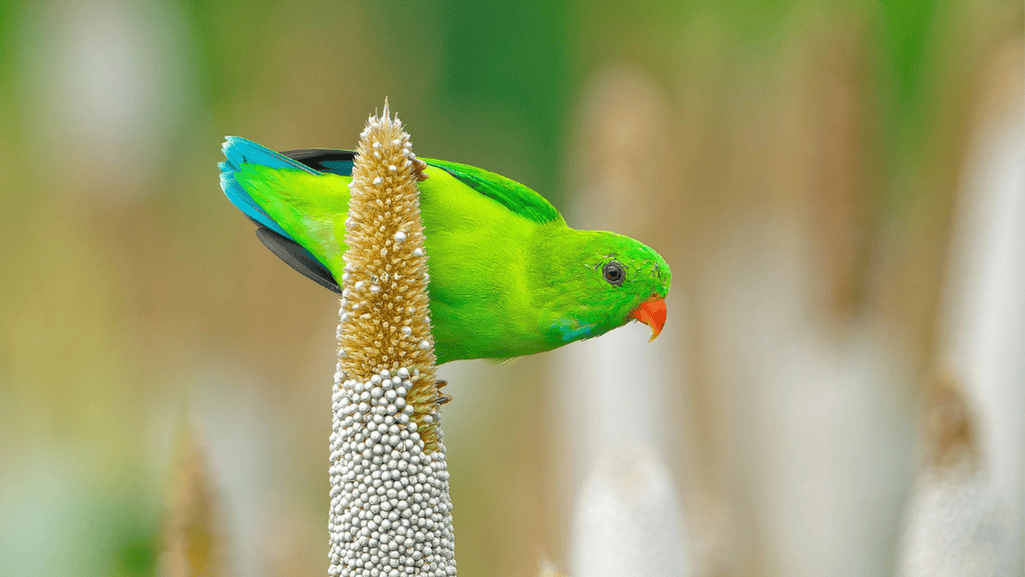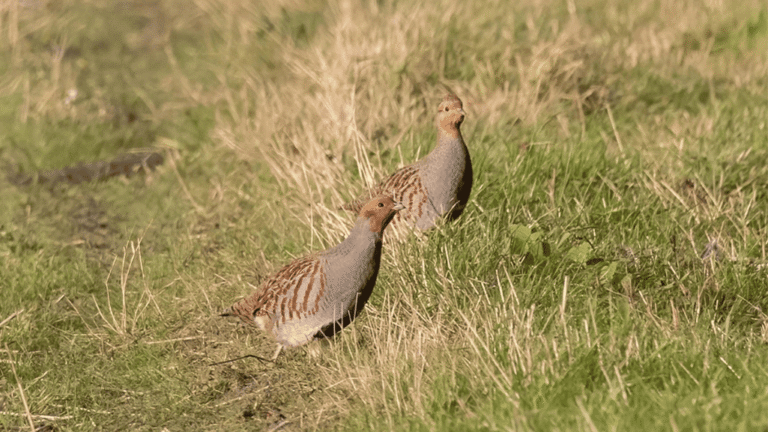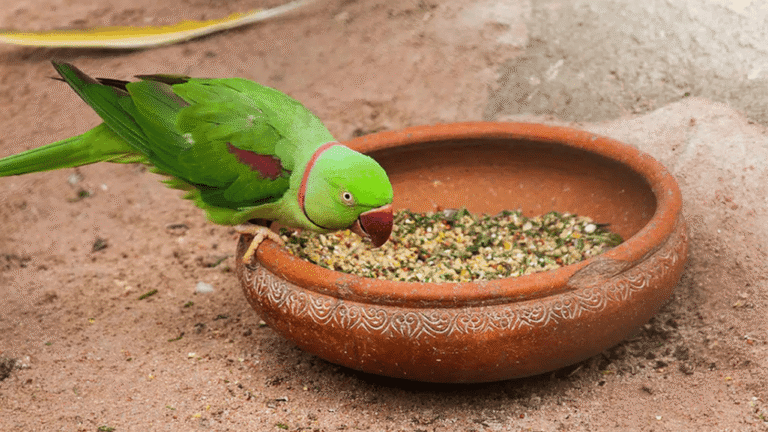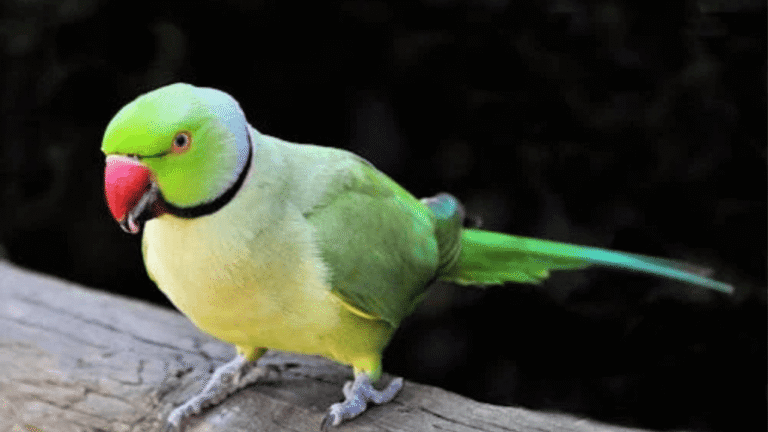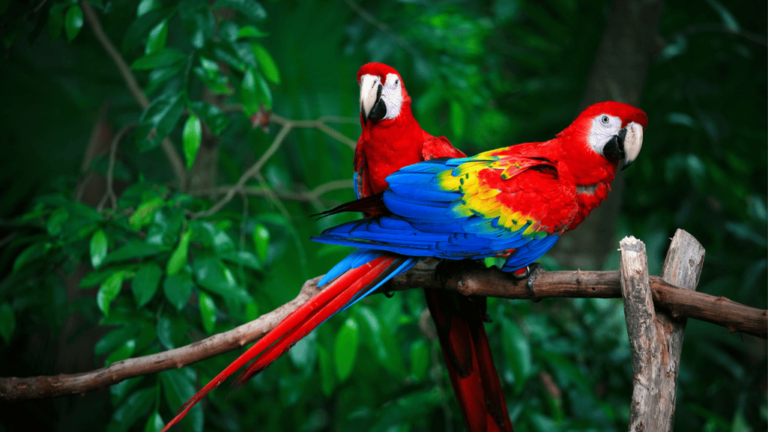The Vernal Hanging Parrot is a vibrant sight in the tropics. It amazes bird lovers with its agility and bright green feathers. This small bird, known as Loriculus vernalis, is found in various habitats up to 1800m high. It’s a bird that fascinates and intrigues many.
The male Vernal Hanging Parrot has a blue throat patch and red markings. The female has a more calm color. They eat insects, fruits, and seeds, showing the richness of their home. What’s unique is how they hang upside down in the forest, like green decorations.
Despite some worries, the Vernal Hanging Parrot is not in danger. It has a stable population, earning it a ‘Least Concern’ status on the IUCN Red List. This means their acrobatic feeding will continue to delight us for a long time.
Key Takeaways
- Discover the Vernal Hanging Parrot, an eye-catching bird species famed for its green parrot likeness and peculiar upside-down resting position.
- Understand the dietary preferences and unique feeding behaviors that define the Loriculus vernalis in its natural habitat.
- Grasp the importance of habitat conservation for maintaining the stable population status and ecological niche of this remarkable avian.
- Learn about the significant elevation range (up to 1800m) where the Vernal Hanging Parrot can be observed and admired.
- Unveil the gender-based color distinctions within Vernal Hanging Parrot Facts, adding layers of depth to the identification and study of these birds.
Introduction to the Vernal Hanging Parrot
The Vernal Hanging Parrot is a small, colorful parrot found in the Indian subcontinent and Southeast Asia. It is known for its unique looks and behaviors. This bird is a favorite among birdwatchers and scientists.
Distinctive Characteristics of Loriculus Vernalis
The Vernal Hanging Parrot, also known as Loriculus vernalis, is about 13 cm long and weighs 28g. It’s a small parrot with a big personality. Males have a green body, a pale blue throat, and a red bill. Females are similar but with a less vibrant throat.
These birds make a variety of sounds. Their calls and songs add to the beauty of tropical birdwatching.
The Unique Roosting Behavior of Hanging Parrots
Vernal Hanging Parrots sleep upside down at night. They find safety in the rainforest canopy. This behavior is rare among small parrots.
Studying these birds helps us understand their survival strategies. It also supports efforts to protect them in their natural habitats.
The Striking Visuals: Vernal Hanging Parrot Images and Colors
The Vernal Hanging Parrot’s bright colors are beautifully shown in Vernal Hanging Parrot images. These pictures highlight the green feathers and the special colors of males and females as they grow.
The male Vernal Hanging Parrot has green feathers, a blue throat patch, and a red rump. This makes him very colorful. The female is similar but has a softer color and no blue on her throat.
Male and Female Plumage Differences
Knowing how males and females look different helps us understand their lives. The males’ bright colors might help them find mates. The females’ softer colors might help them hide when they nest.
Juvenile Vernal Hanging Parrot Appearance
Young Vernal Hanging Parrots are not as colorful. They have grey or green cheeks and a pale orange bill. This early look helps them hide from predators in their leafy homes.
Vernal Hanging Parrot images show more than beauty. They help us learn about these birds’ survival and social lives. They show how these colorful parrot species fit into their environments.
Voice and Sounds: Communicating in the Canopy
The Vernal Hanging Parrot’s communication is as colorful as their feathers. Their sounds are key to their survival and social life in the dense canopies they call home.
The Vernal Hanging Parrot’s sounds include squeaky and high-pitched calls. These are loud during flight but can be heard when they rest too. Sometimes, a soft chuckle can be heard, making their presence even more special.
Their calls are sharp and shrill, cutting through the noise of their habitat. This helps keep the flock together and is important for mating. It also warns others of danger, crucial for their daily lives.
As bird lovers and scientists study these sounds, we learn more about the importance of bird calls in the ecosystem.
| Function | Type of Vocalization |
|---|---|
| Flight Communication | High-pitched calls |
| Resting Alerts | Sharp, shrill notes |
| Social Interaction | Soft chuckling sounds |
| Mating Rituals | Complex melodies |
Learning about the Vernal Hanging Parrot’s sounds helps us understand these amazing birds better. It also shows the importance of their habitats. Each sound in the canopy is a vital part of tropical biodiversity.
Vernal Hanging Parrot Diet and Feeding Habits
The Vernal Hanging Parrot’s diet is full of interesting plants from tropical places. This makes it a great topic for those who love tropical bird diets and wildlife photography. These birds eat a wide range of foods, showing how they adapt to different environments.
Natural Food Sources in the Wild
In the wild, Vernal Hanging Parrots eat fruits, flowers, nectar, and seeds. These foods are key for their bright colors and health. They love Erythrina and Eucalyptus flowers, berries, and seeds from trees like Casuarina and Tectona grandis.
This diet helps them fly fast and live a colorful life. It’s also what makes them look so good in wildlife photos.
Dietary Needs in Captivity
Keeping a Vernal Hanging Parrot in captivity is different. It’s important to feed them like they do in the wild to keep them healthy. A mix of fruits like apple, pear, and guava, with small seeds and sometimes insects, is good.
Adding special foods like sponge cake, nectar, and pellets helps too. This variety keeps them looking their best. It also makes them happy to watch and photograph.
Following these diet tips helps these parrots stay healthy and colorful. They do well whether they’re in the wild or in a home. This is thanks to a mix of native fruits, seeds, and veggies.
Habitat Distribution and Range of the Vernal Hanging Parrot
The Vernal Hanging Parrot is a colorful bird found in India and nearby countries. It lives in various habitat distribution and altitudinal ranges. This bird thrives from sea level to 1800 meters, showing its ability to adapt and survive.
Native Regions and Habitats in Detail
This bird’s home is in Southwest India, Nepal, Bhutan, Bangladesh, and Southeast Asia. It loves the evergreen, deciduous forests and secondary growth areas. It also lives in man-altered environments, adding to the area’s biodiversity.
Altitudinal Range of Vernal Hanging Parrots
The altitudinal range of Vernal Hanging Parrots shows their adaptability. They live from sea level to 1800 meters. They thrive in lush fields and forest edges, using the resources available.
Vernal Hanging Parrots are very resilient. They live in both wild and human-altered landscapes. They play a big role in keeping their habitats balanced, making them important to their ecosystems.
Vernal Hanging Parrot Behavior and Social Dynamics
The vernal hanging parrot behavior is truly captivating. It shows off their agility and sociability, making them a hit with birdwatching fans. These tropical birds live in groups, from pairs to small flocks. This helps them survive and interact in their ecosystem.
Vernal hanging parrots are not just colorful birds. They are also very good at moving around. A study by Young MW et al. (2023) shows how they climb with ease. They use their heads to help them climb, making them agile in dense foliage and adding to the birdwatching thrill.
These birds are also interesting to watch because of how they climb. Reader LL (2022) studied how they climb trees. They use their strong beak to help them move up. This shows how complex their social dynamics are.
For those who want to see these birds up close, Shatchari National Park is a great place. These tropical birds are often seen there. They show off their acrobatic skills and bright colors against the greenery.
Learning about the vernal hanging parrot behavior helps us understand tropical bird life better. Dickinson E et al. (2023) studied how they climb using their tails. This shows how their physical abilities help their social interactions.
In conclusion, the Vernal Hanging Parrot is not just a pretty bird. It also shows us the complex social lives of tropical birds. Their interesting behaviors give us a peek into how they adapt to different environments.
The Vernal Hanging Parrot’s Breeding and Nesting Practices
The Vernal Hanging Parrot is a unique bird in the parrot family. It has special breeding habits and nesting ways. From January to April, these birds get ready for their young.
Breeding Season and Nesting Habits
These parrots find a tree hollow to lay their eggs. They don’t make new nests. Instead, they use old ones to keep their babies safe.
This saves energy for other important tasks. To learn more about their nesting, check out this article on Vernal Hanging Parrot nesting.
Clutch Size and Incubation Details
Vernal Hanging Parrots lay 3 to 4 eggs. Each egg is about 19.0 x 16.0 mm. They incubate for 20 days before the eggs hatch.
The parents take great care of the eggs. This helps the babies survive. At 5 weeks, the babies leave the nest and start learning.
Learning about the Vernal Hanging Parrot’s mating and nesting is fascinating. It helps us understand their life cycle and how to protect them. Bird lovers and researchers can help these colorful birds thrive in their homes.
Conservation Status and Efforts for the Vernal Hanging Parrot
The Vernal Hanging Parrot’s survival depends on global and local conservation efforts. It’s listed as “Least Concern” by the IUCN, but faces threats in some areas. We must understand its needs and take urgent action to save it.
Population Trends and Threats
The Vernal Hanging Parrot faces threats from habitat loss and the illegal pet trade. These issues have made it Near Threatened in some places. Its small size makes it a target for poachers, worsening its situation.
Conservation Actions and CITES Listing
Efforts to save the Vernal Hanging Parrot focus on its key needs. It’s listed under Appendix II of CITES to control trade. Habitat restoration and fighting wildlife trafficking are key. Education programs help protect these birds.
This parrot needs a warm environment, at least 20°C (68°F), like its natural habitat. A varied diet, including fresh fruits and quality seeds, is also essential for their health.
Habitat restoration has made significant progress in recent years. These efforts help restore their natural environments. They also support the parrots’ natural behaviors and diets, crucial for their survival.
In conclusion, efforts to save the Vernal Hanging Parrot, backed by CITES, show a global commitment. Ongoing monitoring and proactive conservation strategies are vital to improve its status.
Vernal Hanging Parrot Care in Aviculture
Understanding the needs of Vernal Hanging Parrots is key in aviculture. It’s important to use knowledge from experts and recent studies in their care. These birds need a space that feels like home, with lots of plants and places to climb.
Creating Suitable Living Environments
Experts suggest using outdoor aviaries for these birds. They should be safe, well-ventilated, and protected from bad weather. The aviaries need plants and branches for climbing and playing.
Keeping the cage clean is also crucial. A clean environment helps prevent health problems. Daily cleaning and disinfection are important steps.
Nutrition and Enrichment in Captivity
Vernal Hanging Parrots need a varied diet. This includes fruits, vegetables, seeds, and nectar. They love berries, figs, and soft fruits, and sometimes eat insects and seeds.
Enrichment activities are also vital. Puzzle feeders help them forage like they do in the wild. This makes them happy and healthy.
Here’s a comparison of the diets and feeding behaviors of Blue-crowned and Vernal Hanging Parrots:
| Characteristic | Blue-crowned Hanging Parrot | Vernal Hanging Parrot |
|---|---|---|
| Diet in Captivity | Fruits, vegetables, seeds, nectar | Fruits, seeds, insects, nectar |
| Typical Feeding Behavior | Prefers wild figs, nectar, small insects | Feeds on berries, figs, and enjoys coconut palm liquor |
| Feeding Enrichment | Uses puzzle feeders to mimic foraging | Engages in similar puzzle-based foraging tasks |
Observing and adjusting their environment and diet is essential. This ensures their health and happiness. Aviculturists play a vital role in preserving these birds for the future.
Conclusion
The Vernal Hanging Parrot is a unique bird that fascinates bird lovers worldwide. It has bright colors and sleeps upside down, making it interesting for birdwatching and photography. Its special diet and home needs highlight the importance of saving tropical birds.
Learning about the Vernal Hanging Parrot shows their love for wild figs and nectar. They face challenges in the wild and in captivity. Keeping them healthy requires careful care, like a warm home and lots of food.
Sanctuaries like the Hanging-parrot and Fig Parrot National Conservatory are key to saving these birds. They help protect their homes and breed them safely. A watchtower in Shatchari National Park is now a place where these parrots are cared for.
Protecting tropical birds is not just a choice; it’s a duty. We must act now to keep the Vernal Hanging Parrot and its beauty alive for future generations.


